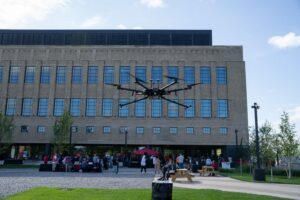
[ad_1]

image credit: Stephen McGee
Old railway station to be site for drone development hub
By DRONELIFE Feature Editor Jim Magill
The city of Detroit and Ford Motor Company are both icons of the U.S. ground transportation industry. Now a Ford subsidiary, the city of Detroit, the state of Michigan and other partners are working together to write the next chapter in the history of regional mobility, by creating a hub for drone innovation.
Centered on an iconic but abandoned train station in Detroit’s historic Corktown neighborhood, Ford affiliate Michigan Central recently joined the Michigan Department of Transportation to launch Detroit’s Advanced Aerial Innovation Region. The new initiative is designed to attract drone company startups, provide high-skills job training and advance public policy to promote the commercialization of drone technology in the state.

image credit: Nadir Ali
“Our goal is to essentially help drone operators who are trying to develop out commercial opportunities to be able to work their way through the beyond visual line of sight (BVLOS) waiver process,” Matt Whitaker, Michigan Central’s innovation platform director, said in an interview.
“Our success will be dictated by our ability to help those companies get through that process and then launch real commercial-scale opportunities.”
The aerial innovation region will be focused not just on developing breakthroughs in drone technology, but also on working in cooperation with the community to solve real-world mobility problems. Whitaker said the initiative envisions a number of opportunities to expand the use of drones across a broad array of applications.
“We see a huge value in medical, pharmaceuticals, food, other small goods deliveries, and building and infrastructure inspection,” he said. “In southwest Detroit, the area that we operate in, there are opportunities for us to help solve real mobility challenges that haven’t been addressed by the traditional mobility solutions.”

image credit: Nadir Ali
Whitaker said Michigan Central is not yet ready to announce specific partners in the venture, although a number of drone-related companies already have expressed an interest in the project. He said he expects to be able to announce the launch of several partnership programs by the first quarter of next year.
“Right now, we’re primarily focused on making sure we have all the pieces in place, to make it successful,” he said.
The Michigan Central district comprises 30 acres, and is anchored by the historic train station. The innovation region, which covers a 3-mile radius around Michigan Central, will provide open, shared infrastructure and services to enable commercial drone development while ensuring safety in the air and on the ground, according to a press release.
Participating drone operators will have access to the region’s facilities as well as its operational support. “The initiative will propel solutions focused on addressing accessibility, safety, tech equity and regulatory challenges by testing potential commercial drone uses,” the statement says.
The goal of the creation of the region is “to future-proof Michigan’s status as a mobility solutions epicenter and stake a claim to jobs and economic opportunities in an industry predicted to top $50 billion by 2030.”
Under the partnership agreement, Michigan Central will provide resources for foundational infrastructure, community engagement and skills training, while the state transportation department will manage the network and define its operating parameters, as well as establish data and safety protocols. Flight data from all pilots in the program will be collected and used to achieve the innovation region’s goal of increasing the awarding of BVLOS certifications for participating operators.
The partnership will also include the participation of Newlab, a multi-disciplinary technology center, and Airspace Link, an aviation software company, which will support activation and development of the innovation region’s program.
Newlab will work to mobilize startups and other industry partners through the creation of pilot projects aimed at de-risking and accelerating the commercial-scale development of high-value drone applications.
Airspace Link will provide the platform and processes to support safe operations in real-world urban environments. Its platform creates digital mapping using more than 60 data sources to help drone operators understand ground and airspace risks at any given time while simplifying flight authorization requests to the FAA. In addition, Airspace Link will work to increase public awareness so that Detroit residents can understand which flights, plans and programs will happen in their area.

image credit: Airspace Link
The initiative also includes the participation of leading academic institutions that will conduct research to advance UAS technologies and policies, and increase public awareness of the benefits of drone technology. The first such project is a study by the Massachusetts Institute of Technology (MIT) to build a model that represents future drone flights in Detroit.
The goal of the MIT study is to identify inequities in the predicted drone traffic and infrastructure and determine what policy interventions might be required to ensure a more equitable future as commercial development of the industry grows.
Whitaker said the location of Michigan Central makes it an ideal place to serve as a hub of drone innovation. “Around us we have significant land and other assets that we’re able to use to create those spaces for the drone operations,” he said. In addition, because the site served as the center for rail transportation, it has ample access to tracks that can carry goods and materials into and out of the region.
Because the site is in the heart of Corktown, the city’s oldest community, and not far from downtown Detroit to the east, it is the ideal location to test the feasibility of conducting drone operations in both residential and urban environments.
“We have the ability to do some interesting work within our space without necessarily interfering with people’s way of life. And yet at the same time, the drone opportunities that surround us — where we can do actual, meaningful commercial viability testing — are also real,” he said.
Read more:
 Jim Magill is a Houston-based writer with almost a quarter-century of experience covering technical and economic developments in the oil and gas industry. After retiring in December 2019 as a senior editor with S&P Global Platts, Jim began writing about emerging technologies, such as artificial intelligence, robots and drones, and the ways in which they’re contributing to our society. In addition to DroneLife, Jim is a contributor to Forbes.com and his work has appeared in the Houston Chronicle, U.S. News & World Report, and Unmanned Systems, a publication of the Association for Unmanned Vehicle Systems International.
Jim Magill is a Houston-based writer with almost a quarter-century of experience covering technical and economic developments in the oil and gas industry. After retiring in December 2019 as a senior editor with S&P Global Platts, Jim began writing about emerging technologies, such as artificial intelligence, robots and drones, and the ways in which they’re contributing to our society. In addition to DroneLife, Jim is a contributor to Forbes.com and his work has appeared in the Houston Chronicle, U.S. News & World Report, and Unmanned Systems, a publication of the Association for Unmanned Vehicle Systems International.
Miriam McNabb is the Editor-in-Chief of DRONELIFE and CEO of JobForDrones, a professional drone services marketplace, and a fascinated observer of the emerging drone industry and the regulatory environment for drones. Miriam has penned over 3,000 articles focused on the commercial drone space and is an international speaker and recognized figure in the industry. Miriam has a degree from the University of Chicago and over 20 years of experience in high tech sales and marketing for new technologies.
For drone industry consulting or writing, Email Miriam.
TWITTER:@spaldingbarker
Subscribe to DroneLife here.
[ad_2]